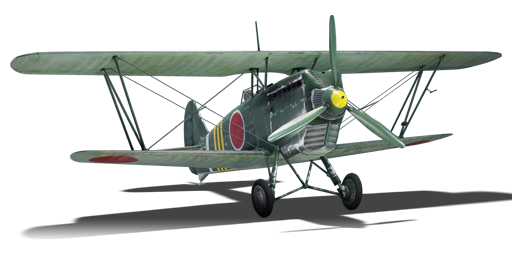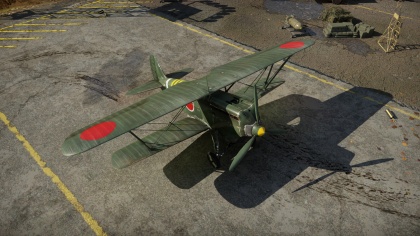Ki-10-I C
Contents
| This page is about the aircraft Ki-10-I C. For other uses, see Ki-10 (Disambiguation) |
Description
The Ki-10-I C is a Rank I reserve Japanese biplane fighter
with a battle rating of 1.0 (AB/RB/SB). It has been in the game since the start of the Open Beta Test prior to Update 1.29.
The Ki-10-I C is a reserve biplane fighter for the Japanese Faction. Like all biplanes, the Ki-10-I C has a low top speed, high turn rate, good-to-fair climbing ability, nearly no armor, and, in realistic and simulator battles, a ridiculously short take-off length. Compared to other biplanes, the Ki-10-I C is faster and climbs easier, with similar armament and maneuverability, but with (marginally) weaker armor. The Ki-10-I C is not noticeably different from the Ki-10-I
The Ki-10-I C's low speed and tight turning ability makes it a great turn-fighter, like most Japanese light fighters. The Ki-10-I C excels at low and slow turn fighting at very low altitudes where enemies cannot out-dive it. Additionally, it has the climb rate to climb away from enemy biplanes. Very fast dives should be avoided, as the wings will shear off at very high speeds. Similarly, turning stalls should be avoided, as the Ki-10-I has a tendency to enter uncontrollable spins.
It's twin 7.7 mm armament is one of the weakest in the game, so strafing attacks on all but the least armored targets are not recommended; Artillery, vehicles, and landing craft are the primary targets, while the Ki-10-I C's weak construction makes attacking AAA and bombers risky propositions, but not impossible. Cargo Ships, tanks and armored cars are invulnerable to the Ki-10-I C. Instead, the best Ki-10-I C targets are other biplanes or slow monoplanes, such as P-26s, Fury Mk Is or Nimrod Mk Is. Like most other planes, the Ki-10-I C works better in numbers. Ki-10 pilots should focus primary on sticking together and working as a team.
General info
Flight Performance
| Characteristics | |||||||
|---|---|---|---|---|---|---|---|
| Stock | |||||||
| Max Speed (km/h at 4,000 m) |
Max altitude (meters) |
Turn time (seconds) |
Rate of climb (meters/second) |
Take-off run (meters) | |||
| AB | RB | AB | RB | AB | RB | ||
| ? | ? | 8100 | ??.? | ??.? | ??.? | ??.? | 232 |
| Upgraded | |||||||
| Max Speed (km/h at 4,000 m) |
Max altitude (meters) | Turn time (seconds) | Rate of climb (meters/second) |
Take-off run (meters) | |||
| AB | RB | AB | RB | AB | RB | ||
| ? | ? | 8100 | ??.? | ??.? | ??.? | ??.? | 232 |
Details
| Features | ||||
|---|---|---|---|---|
| Combat flap | Take-off flap | Landing flap | Air brakes | Arrestor gear |
| X | X | X | X | X |
| Limits | ||||
|---|---|---|---|---|
| Wing-break speed (km/h) |
Gear limit (km/h) |
Combat flap (km/h) |
Max Static G | |
| + | - | |||
| 600 | 560 | ??? | ~14 | ~8 |
| Optimal velocities | |||
|---|---|---|---|
| Ailerons (km/h) |
Rudder (km/h) |
Elevators (km/h) |
Radiator (km/h) |
| < 320 | < 320 | < 320 | > 200 |
| Compressor (RB/SB) | ||
|---|---|---|
| Setting 1 | ||
| Optimal altitude | 100% Engine power | WEP Engine power |
| 3,500 m | 800 hp | 944 hp |
Survivability and armour
- No armour plating
- No armour glazing
- Critical components located at front of aircraft (fuel, pilot, engine, controls)
- More fuel tanks located in wings near fuselage
Armaments
Offensive armament
Usage in the battles
Manual Engine Control
| MEC elements | ||||||
|---|---|---|---|---|---|---|
| Mixer | Pitch | Radiator | Supercharger | Turbocharger | ||
| Oil | Water | Type | ||||
| Controllable | Not controllable | Not controllable | Not controllable | Separate | Not ontrollable | Not controllable |
Modules
| Tier | Flight performance | Survivability | Weaponry | ||
|---|---|---|---|---|---|
| I | Fuselage Repair | Radiator | |||
| II | Compressor | Airframe | |||
| III | Wings Repair | Engine | |||
| IV | Engine Injection | Cover | |||
- For such low rank vehicles the order of research does not really matter. Improvements in firepower by new belts and new machine guns help a lot in arcade battles. For realistic mode, performance upgrades are more often necessary.
Pros and cons
Pros:
- Great Maneuverability
- Low Stall Speed
- Fast Top Speed (for a Biplane)
- Good Climb Rate (for a Biplane)
Cons:
- Weak Armor
- Poor Diving Ability
- Poor Spin Characteristics
History
The Kawasaki Ki-10 was the last Biplane fighter used by the Japanese Army. Introduced in 1935, it beat the competing Nakijima K-11 (which would later be refined as the Ki-27) as the Imperial Japanese Army Air Force placed more priority on maneuverability than speed. Its excellent maneuverability made it extremely popular with Japanese pilots, who demanded similar high maneuverability from newer aircraft. Over the course of its service the fighter would be refined several times with the ultimate version, the Ki-10-II, appearing in 1937.
The K-10 saw service against Chinese air forces in the early stages of the Second Sino-Japanese War and against Soviet air forces during the battles of Khalkhin Gol (where it historically outperformed the Soviet I-15). It formed the backbone of the IJAAF fighter forces until 1940, but it was considered obsolete by Western military experts as early as 1938. By the start of the Pacific War, the Ki-10 had been regulated to training and courier roles, and received the Allied reporting name "Perry".
There are no known incidents where the Ki-10 engaged American- or British-crewed aircraft, though the Japanese fighter did fight Chinese National P-26s, and may have engaged British-built Gladiators, Italian CR.32s (predecessor of the CR.42 ), and Soviet I-15's, all crewed by Chinese pilots, during the early battles of the war.
Media
An excellent addition to the article will be video guides, as well as screenshots from the game and photos.
Read also
- HistoryOfWar.org's page of the "Kawasaki Ki-10 'Perry'"
- "Håkans aviation page" - Ki-10
- Wikipedia Article on Ki-10
Sources
Paste links to sources and external resources, such as:
- topic on the official game forum;
- page on aircraft encyclopedia;
- other literature.
| Japan fighters | |
|---|---|
| Navy | |
| Carrier-based fighter | |
| A5M | A5M4 · Hagiri's A5M4 |
| A6M | A6M2 mod. 11 · A6M2 · A6M3 · A6M3 mod. 22 · A6M3 mod. 22Ko · A6M5 · A6M5 Ko · A6M5 otsu · A6M5 Hei · A6M6c |
| A7He | A7He1* |
| A7M | A7M1 (NK9H) · A7M2 |
| Land-based Fighter | |
| J2M | J2M2 · J2M3 · J2M4 Kai · J2M5 · J2M5 (30 mm) |
| J6K | J6K1 |
| J7W | J7W1 |
| N1K-J | N1K1-Ja · N1K2-J · N1K2-Ja |
| Fighter seaplane | |
| N1K | N1K1 |
| A6M-N | A6M2-N |
| Army | |
| Ki-10 | Ki-10-I · Ki-10-I C · Ki-10-II · Ki-10-II C |
| Ki-27 | Ki-27 otsu · Ki-27 otsu Tachiarai |
| Ki-43 | Ki-43-I · Ki-43-II · Ki-43-III otsu |
| Ki-44 | Ki-44-I · Ki-44-I 34 · Ki-44-II otsu · Ki-44-II hei |
| Ki-61 | Ki-61-I ko · Ki-61-I otsu · Ki-61-I hei · Tada's Ki-61-I hei · Ki-61-I tei · Ki-61-II Otsu Kai |
| Ki-84 | Ki-84 ko · Ki-84 otsu · Ki-84 hei |
| Ki-87 | Ki-87 |
| Ki-94 | Ki-94-II |
| Ki-100 | Ki-100 · Ki-100-II |
| Other countries | ▅F4U-1A · ▅P-51C-11-NT · ▅Bf 109 E-7 · ▅Fw 190 A-5 |
| *Imported designation of the He 112 (A6M was in development - A7M would take A7 designation after the cancelation of the A7He) | |





